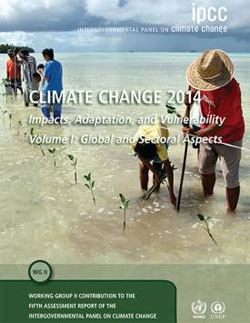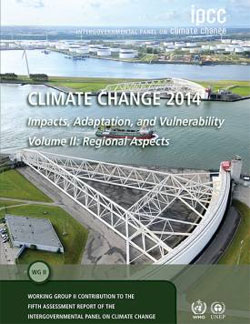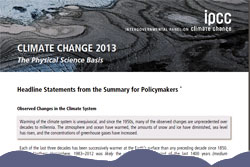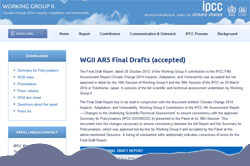 |
 |
|
Today Monday 31 March, the United Nations Intergovernmental Panel on Climate Change (IPCC) published ‘Climate Impacts, Adaptation and Vulnerability’. This is the second part of their latest report into climate change. The IPCC says the effects of climate change are already occurring on all continents and across the oceans. The world, in many cases, is ill-prepared for risks from a changing climate. The report also concludes that there are opportunities to respond to such risks, though the risks will be difficult to manage with high levels of warming.
The report concludes that responding to climate change involves making choices about risks in a changing world. The nature of the risks of climate change is increasingly clear, though climate change will also continue to produce surprises. In announcing the publication of their report in Yokohama, Japan, the chair of the Intergovernmental Panel on Climate Change said the impacts of Climate Change are likely to be "severe, pervasive, and irreversible." Researched and evidenced by the world's leading climate experts, the report details how our planet is likely to change in the near future, and what we can do about it. But the storm of apathy has already raised its head, as those who don't wish to face reality, accuse the scientists of being 'alarmist'. The report identifies vulnerable people, industries, and ecosystems around the world. It finds that risk from a changing climate comes from vulnerability (lack of preparedness) and exposure (people or assets in harm’s way) overlapping with hazards (triggering climate events or trends). Each of these three components can be a target for smart actions to decrease risk. “We live in an era of man-made climate change,” said Vicente Barros, Co-Chair of Working Group II. “In many cases, we are not prepared for the climate-related risks that we already face. Investments in better preparation can pay dividends both for the present and for the future.” Adaptation to reduce the risks from a changing climate is now starting to occur, but with a stronger focus on reacting to past events than on preparing for a changing future, according to Chris Field, Co-Chair of Working Group II. “Climate-change adaptation is not an exotic agenda that has never been tried. Governments, firms, and communities around the world are building experience with adaptation,” Field said. “This experience forms a starting point for bolder, more ambitious adaptations that will be important as climate and society continue to change.” Future risks from a changing climate depend strongly on the amount of future climate change. Increasing magnitudes of warming increase the likelihood of severe and pervasive impacts that may be surprising or irreversible. “With high levels of warming that result from continued growth in greenhouse gas emissions, risks will be challenging to manage, and even serious, sustained investments in adaptation will face limits,” said Field.
“The report concludes that people, societies, and ecosystems are vulnerable around the world, but with different vulnerability in different places. Climate change often interacts with other stresses to increase risk,” Field said. Adaptation can play a key role in decreasing these risks, Barros noted. “Part of the reason adaptation is so important is that the world faces a host of risks from climate change already baked into the climate system, due to past emissions and existing infrastructure,” said Barros. Field added: “Understanding that climate change is a challenge in managing risk opens a wide range of opportunities for integrating adaptation with economic and social development and with initiatives to limit future warming. We definitely face challenges, but understanding those challenges and tackling them creatively can make climate-change adaptation an important way to help build a more vibrant world in the near-term and beyond.” Rajendra Pachauri, Chair of the IPCC, said: “The Working Group II report is another important step forward in our understanding of how to reduce and manage the risks of climate change. Along with the reports from Working Group I and Working Group III, it provides a conceptual map of not only the essential features of the climate challenge but the options for solutions.” “None of this would be possible without the dedication of the Co-Chairs of Working Group II and the hundreds of scientists and experts who volunteered their time to produce this report, as well as the more than 1,700 expert reviewers worldwide who contributed their invaluable oversight,” Pachauri said. “The IPCC’s reports are some of the most ambitious scientific undertakings in human history, and I am humbled by and grateful for the contributions of everyone who make them possible." A total of 309 coordinating lead authors, lead authors, and review editors, drawn from 70 countries, were selected to produce the report. They enlisted the help of 436 contributing authors, and a total of 1,729 expert and government reviewers. In a press release issued today, the Foreign Secretary, William Hague, addressed the urgency of the report’s latest findings, stating that: To those who are 'climate change sceptics' it would be an idea to watch the David Attenborough documentary made in 2007, and then recall the floods of 2013/14 in the UK! Further concern is that of ozone levels in the lower atmosphere. In the lower levels of the atmosphere, high concentrations of ozone are poisonous to people and animals as well as plants. The ozone levels are forecast to rise. This ten minute video produced for the IPC, explains simply what human beings are doing to our planet. The IPCC has issued a press release detailing the major headlines from their 'Climate Change 2013 The Physical Science Basis' report issued January 2014: Observed Changes in the Climate System Each of the last three decades has been successively warmer at the Earth’s surface than any preceding decade since 1850. The rate of sea level rise since the mid-19th century has been larger than the mean rate during the previous two millennia. Over the period 1901 to 2010, global mean sea level rose by 0.19 [0.17 to 0.21] m.
Total radiative forcing is positive, and has led to an uptake of energy by the climate system. The largest contribution to total radiative forcing is caused by the increase in the atmospheric concentration of CO2 since 1750. Understanding the Climate System and its Recent Changes Human influence on the climate system is clear. This is evident from the increasing greenhouse gas concentrations in the atmosphere, positive radiative forcing, observed warming, and understanding of the climate system. Climate models have improved since the Assessment Report 4. Models reproduce observed continental-scale surface temperature patterns and trends over many decades, including the more rapid warming since the mid-20th century and the cooling immediately following large volcanic eruptions. Future Global and Regional Climate Change Continued emissions of greenhouse gases will cause further warming and changes in all components of the climate system. Limiting climate change will require substantial and sustained reductions of greenhouse gas emissions. Global surface temperature change for the end of the 21st century is likely to exceed 1.5°C relative to 1850 to 1900 for all Representative Concentration Pathways (RCP) scenarios except 2.6. It is likely to exceed 2°C for RCP6.0 and RCP8.5, and more likely than not to exceed 2°C for RCP4.5. Warming will continue beyond 2100 under all RCP scenarios except RCP2.6.
The global ocean will continue to warm during the 21st century. Heat will penetrate from the surface to the deep ocean and affect ocean circulation. It is very likely that the Arctic sea ice cover will continue to shrink and thin and that Northern Hemisphere spring snow cover will decrease during the 21st century as global mean surface temperature rises. Global glacier volume will further decrease. Global mean sea level will continue to rise during the 21st century. Under all RCP scenarios, the rate of sea level rise will very likely exceed that observed during 1971 to 2010 due to increased ocean warming and increased loss of mass from glaciers and ice sheets. Climate change will affect carbon cycle processes in a way that will exacerbate the increase of CO2 in the atmosphere. Further uptake of carbon by the ocean will increase ocean acidification. Cumulative emissions of CO2 largely determine global mean surface warming by the late 21st century and beyond. Most aspects of climate change will persist for many centuries even if emissions of CO2 are stopped. This represents a substantial multi-century climate change commitment created by past, present and future emissions of CO2. The full report, it’s summary, and additional documentation can be downloaded from the IPCC Climate Change Working Group II website here Source: IPCC / Met Office / Unionsafety |


 Drivers of Climate Change
Drivers of Climate Change